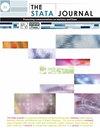lgrgtest:约束最大似然估计后的拉格朗日乘数检验
IF 3.2
2区 数学
Q1 SOCIAL SCIENCES, MATHEMATICAL METHODS
引用次数: 0
摘要
除了Wald检验和似然比检验,拉格朗日乘数检验(Rao, 1948,《剑桥哲学学会数学论文集》44:50-57;艾奇逊和西尔维,1958,数理统计年鉴29:813-828;Silvey, 1959, Annals of Mathematical Statistics 30: 389-407)是继极大似然估计之后检验假设的第三个规范方法。虽然Stata命令test和lrtest实现了前两个功能,但Stata没有用于实现第三个功能的官方命令。社区贡献的引导包(Roodman et al., 2019, Stata Journal 19:4 - 60)侧重于引导推理的方法,并实现了拉格朗日乘子测试功能。在本文中,我将介绍新的社区贡献的后估计命令lgrgtest,它允许在受限的最大似然估计之后直接使用拉格朗日乘数测试。lgrgtest旨在与所有使用最大似然的Stata估计命令兼容,并允许使用constraints()、iterate()和from()选项。Lgrgtest也可以在cnsregg之后使用。本文章由计算机程序翻译,如有差异,请以英文原文为准。
lgrgtest: Lagrange multiplier test after constrained maximum-likelihood estimation
Besides the Wald and likelihood-ratio tests, the Lagrange multiplier test (Rao, 1948, Mathematical Proceedings of the Cambridge Philosophical Society 44: 50–57; Aitchison and Silvey, 1958, Annals of Mathematical Statistics 29: 813–828; Silvey, 1959, Annals of Mathematical Statistics 30: 389–407) is the third canonical approach to testing hypotheses after maximum likelihood estimation. While the Stata commands test and lrtest implement the first two, Stata does not have an official command for implementing the third. The community-contributed boottest package (Roodman et al., 2019, Stata Journal 19: 4–60) focuses on methods of bootstrap inference and also implements the Lagrange multiplier test functionality. In this article, I introduce the new community-contributed postestimation command lgrgtest, which allows for straightforwardly using the Lagrange multiplier test after constrained maximum-likelihood estimation. lgrgtest is intended to be compatible with all Stata estimation commands that use maximum likelihood and allow for the options constraints(), iterate(), and from(). lgrgtest can also be used after cnsreg.
求助全文
通过发布文献求助,成功后即可免费获取论文全文。
去求助
来源期刊

Stata Journal
数学-统计学与概率论
CiteScore
7.80
自引率
4.20%
发文量
44
审稿时长
>12 weeks
期刊介绍:
The Stata Journal is a quarterly publication containing articles about statistics, data analysis, teaching methods, and effective use of Stata''s language. The Stata Journal publishes reviewed papers together with shorter notes and comments, regular columns, book reviews, and other material of interest to researchers applying statistics in a variety of disciplines.
 求助内容:
求助内容: 应助结果提醒方式:
应助结果提醒方式:


